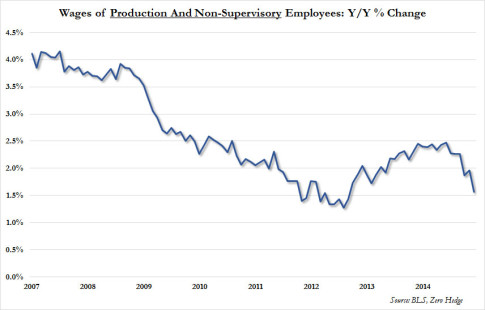– The Mystery Of America’s Missing Wage Growth Has Been Solved (ZeroHedge, March 12, 2015):
One of the biggest conundrums, one that has profound monetary policy implications, and that has been stumping the Fed for the past year is how can it be possible that with 5.5% unemployment there is virtually no wage growth. The mystery only deepens when the Fed listens to so-called economist experts who tell it wage growth is imminent, if not here already, and it is merely not being captured by the various data series. Friday’s jobs data merely confirmed that since the Lehman crash there has been virtually no real wage growth, as the increase in nominal average hourly earnings is right on top of the Fed’s inflation target, instead of where Yellen would like to see it: somewhere in the vicinity of 4%.
And yet, when sophisticated, erudite pundits, usually from a paid leadership position, look at the data, they say wages are growing.
How is that possible?
Actually, the mystery only deepens when one looks not at the wages for the set of All Employees as shown above, but for the 80% or so classified by the BLS as “production and non-supervisory employees” who “account for approximately four-fifths of the total employment on private nonfarm payrolls.” The Bureau of Labor Statistics defines them as follows:
Production and related employees include working supervisors and all nonsupervisory employees (including group leaders and trainees) engaged in fabricating, processing, assembling, inspecting, receiving, storing, handling, packing, warehousing, shipping, trucking, hauling, maintenance, repair, janitorial, guard services, product development, auxiliary production for plant’s own use (for example, power plant), recordkeeping, and other services closely associated with the above production operations.
Nonsupervisory employees include those individuals in private, service-providing industries who are not above the working-supervisor level. This group includes individuals such as office and clerical workers, repairers, salespersons, operators, drivers, physicians, lawyers, accountants, nurses, social workers, research aides, teachers, drafters, photographers, beauticians, musicians, restaurant workers, custodial workers, attendants, line installers and repairers, laborers, janitors, guards, and other employees at similar occupational levels whose services are closely associated with those of the employees listed.
The BLS adds that “these groups account for approximately four-fifths of the total employment on private nonfarm payrolls.” The remainder is the opposite: those which the LA Times defines as “primarily employed to direct, supervise, or plan the work of others.”
In other words “working-supervisors”, bosses, and other job “leaders.”
The important math: production and non-supervisory employees, those not in leadership positions, represent 80% of the employed labor force. This is important when looking at the next chart which show the annual increases in hourly earnings just for production and nonsupervisory employees.
It is as this point that we ask that all economists avert their eyes, because it gets ugly:
As the BLS reports, not only is the annual wage growth of 80% of the work force not growing, but it is in fact collapsing to the lowest levels since the Lehman crisis!
But if the wages of the non-working supervisory 80% of the labor population are tumbling while all wages are flat that must mean that the wages of America’s supervisors, aka “bosses” are…
Bingo.
The chart below shows what the implied annual change in supervisor hourly earnings has been since the start of the second Great Depression. Note the recent differences with the chart immediately above.
And there, ladies and gentlemen, is your soaring wage growth: all of it going straight into the pockets of those lucky 20% of America’s workers who are there to give orders, to wear business suits, and to sound important.
Yes – wages are growing, for those who least need said wage growth, the “people in charge.”
In other words, precisely all those economists who day after day repeat that, damn what reality says, wages are rising.
Well, guess what: they are absolutely right … when referring to their own wages! It is the small matter of everyone else’s wages that they are dead wrong about.
So the next time anyone asks why there is no broad-based pick up in consumer retail spending across the entire population, just show them the above charts.
And with that, the mysterious case of America’s missing wage growth is now closed.
Source: BLS, St. Louis Fed


